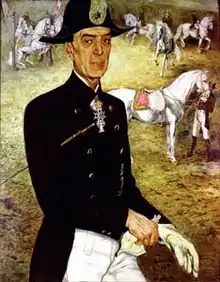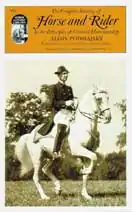

| Olympic medal record | ||
|---|---|---|
| Equestrian | ||
| 1936 Berlin | Dressage individual[1] | |
Alois Podhajsky (24 February 1898 – 23 May 1973) was the director of the Spanish Riding School in Vienna, Austria as well as an Olympic medal-winner in dressage, riding instructor, and writer.[2] He competed at the 1936 Summer Olympics and the 1948 Summer Olympics.[3]
Career
Podhajsky was born in Mostar, Bosnia and Herzegovina, and was an officer in the Austrian Army, rising to the rank of colonel. In 1939, Podhajsky became chief of the Academy of Classical Horsemanship, better known as the Spanish Riding School of Vienna, Austria. Founded in 1572, the school's main focus was the training of Lipizzan horses in the art of classical dressage.[4][5] Podhajsky was director of the school throughout World War II and continued in the position until his retirement in 1965.[6] Following his retirement, he continued to teach classical horsemanship, and wrote a number of books on the topic. Podhajsky died following a stroke in 1973, in Vienna, Austria.[6]
Relocation during World War II
During World War II, worried for the safety of the school and the horses due to bombing raids on Vienna, Podhajsky evacuated most of the stallions out of the city to Sankt Martin im Innkreis in Upper Austria.[7] A number of mares from the Piber Federal Stud, the breeding farm that supplied horses for the school, were also evacuated.[4]
Though the horses were in relative safety, there were still harsh challenges; there was little food for human or animals, and starving refugees sometimes attempted to steal the horses, viewing them as a source of meat.[8] As American General George Patton was leading his troops through Austria, he was alerted to the presence of the Lipizzans in Sankt Martin im Mühlkreis.[9] Patton and Podhajsky had each competed in equestrian events at the Olympic Games.[10][11][12] The two men renewed their acquaintance, and after Podhajsky orchestrated an impressive performance by the remaining horses and riders of the school in front of Patton (a lifelong horseman) and Undersecretary of War Robert P. Patterson, the Americans agreed to place the stallions under the protection of the United States for the duration of the war.[8] Podhajsky later wrote about these events, an account which was made into a motion picture Miracle of the White Stallions by Walt Disney studios, with actor Robert Taylor playing Colonel Podhajsky.
Podhajsky alerted Patton to the location of additional Lipizzan bloodstock. Many Lipizzan mares and some stallions had been appropriated by the Germans from the Austrian breeding farm at Piber and sent to Hostau, to a Nazi-run stud farm in Czechoslovakia (now the Czech Republic).[8] When Hostau fell behind Soviet lines, captured German officers, under interrogation by U.S. Army Captain Ferdinand Sperl, provided details on the Lipizzans' location and asked the Americans to rescue the horses before they fell into Soviet hands, because it was feared they would be slaughtered for horsemeat. Patton issued orders, and on 28 April 1945 Colonel Charles H. Reed, with members of Troops A, C and F of the 2nd Cavalry Regiment, conducted a raid behind Soviet lines, accepted the surrender of the Germans at Hostau, and evacuated the horses.[8] The Lipizzans were relocated to Wels, then to Wimsbach, Upper Austria.[4]
After the war, the Lipizzan stallions finally returned to Vienna in the autumn of 1955.[13][14]
Legacy
Podhajsky is remembered most for saving the Lipizzans, preserving their history following the war, as well as for his dedication to the advancement of classical dressage, and his contributions to the Spanish Riding School.
We must live for the school. Offer our lives to it. Then, perhaps, little by little, the light will grow from the tiny candle we keep lit here, and the great art—of the haute école—will not be snuffed out.
— Alois Podhajsky[2]
He was awarded Order of Saint Sava.[15]
See also
Bibliography
- Podhajsky, Alois (1948). The Spanish Riding School. Vienna.
{{cite book}}: CS1 maint: location missing publisher (link) - Podhajsky, Alois (1963). The White Stallions of Vienna. City: Nymphenburger Verlagshandlung. p. 201 pages. ISBN 978-3-485-01710-7.
- Podhajsky, Alois (1965). My Dancing White Horses: The Autobiography of Alois Podhajsky. City: Holt, Rinehart, and Winston. ASIN B000WSHVZM.
- Podhajsky, Alois (1967). The Complete Training of Horse and Rider. The Sportsman's Press. p. 292 pages. ISBN 0-948253-51-7.
- Podhajsky, Alois (1969). The Lipizzaners. Garden City: Doubleday. ISBN 978-0-385-02807-3.
- Podhajsky, Alois (1976). The Art of Dressage. Garden City: Doubleday. ISBN 0-385-01552-6.
- Podhajsky, Alois (1993). The Riding Teacher: A Basic Guide to Correct Methods of Classical Instruction. North Pomfret, Vt: Trafalgar Square Publishing. p. 204 pages. ISBN 0-943955-84-X.
- Podhajsky, Alois (1997). My Horses, My Teachers. North Pomfret, Vt: Trafalgar Square Publishing. p. 202 pages. ISBN 1-57076-091-8.
- Podhajsky, Alois (2001). Meine Lehrmeister die Pferde. Erinnerungen an ein großes Reiterleben. German: Franckh-Kosmos Verlag. p. 224 pages. ISBN 3-440-08075-7.
References
- ↑ DatabaseOlympics. "Alois Podhajsky". DatabaseOlympics. Archived from the original on 29 September 2007. Retrieved 7 October 2007.
- 1 2 Podhajsky, Alois (2004). The Complete Training of Horse and Rider. The Sportsman's Press. p. 292 pages. ISBN 0-948253-51-7.
- ↑ Evans, Hilary; Gjerde, Arild; Heijmans, Jeroen; Mallon, Bill; et al. "Alois Podhajsky Olympic Results". Olympics at Sports-Reference.com. Sports Reference LLC. Archived from the original on 18 April 2020. Retrieved 17 April 2020.
- 1 2 3 "The History". Spanish Riding School Vienna. Archived from the original on 5 January 2011. Retrieved 31 December 2010.
- ↑ equiworld.net (2007). "The Lipizzaner". equiworld.net. Archived from the original on 27 September 2007. Retrieved 8 October 2007.
- 1 2 Staff (4 June 1973). "Obituaries". Time. Archived from the original on 14 December 2008. Retrieved 7 October 2007.
- ↑ Staff (12 April 1963). "The Last of the War Horses". Time. Archived from the original on 22 December 2008. Retrieved 7 October 2007.
- 1 2 3 4 Lipizzaner.com - White Stallion Productions (2007). "United States 2nd Cavalry Rescued Rare and Noble Lipizzaner Stallions". White Stallion Productions. Archived from the original on 25 October 2007. Retrieved 8 October 2007.
- ↑ Letts, Elizabeth. 2016. The Perfect Horse: The Daring U.S. Mission to Rescue the Priceless Stallions Kidnapped by the Nazis. Ballantine Books.
- ↑ Diane Wright (2005). "Horses to show moves in Everett". The Seattle Times. Retrieved 7 October 2007.
- ↑ Brandon Swanson (2006). "They saved horses". The Prague Post. Archived from the original on 24 August 2008. Retrieved 7 October 2007.
- ↑ Staff (20 November 1950). "A Part of Culture". Time. Archived from the original on 31 January 2011. Retrieved 7 October 2007.
- ↑ Spanish Riding School of Vienna. "History of the Spanish Riding School of Vienna". Spanish Riding School of Vienna. Archived from the original on 5 October 2007. Retrieved 7 October 2007.
- ↑ The Spanish Riding School (2007). "History of the Spanish Riding School". The Spanish Riding School. Archived from the original on 6 September 2007. Retrieved 7 October 2007.
- ↑ Acović, Dragomir (2012). Slava i čast: Odlikovanja među Srbima, Srbi među odlikovanjima. Belgrade: Službeni Glasnik. p. 647.
External links
- Video from Austria, c. 1950s, of SRS, includes footage of Podhajsky
- Spanish Riding School
- Spanish Riding School of Vienna
- Official Lipizzaner Site
- Podhajsky profile with picture Archived 9 February 2008 at the Wayback Machine (in German)
- Miracle of the White Stallions at IMDb
- Excerpt from My Horses, My Teachers, (Meine Lehrmeister die Pferde) on Lipizzan.com.
- dataOlympics profile
- Quotes by Podhajsky at Classical Dressage.com